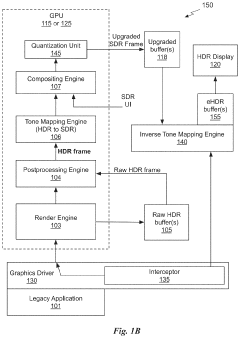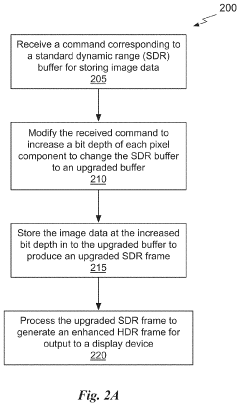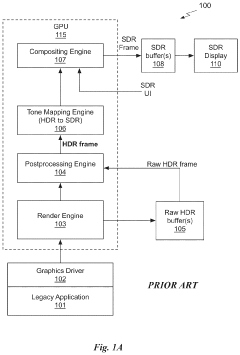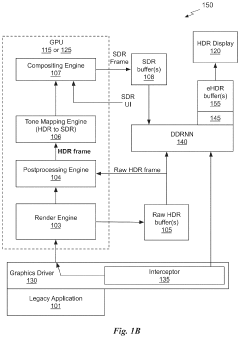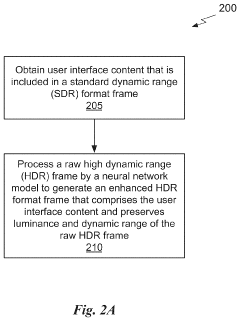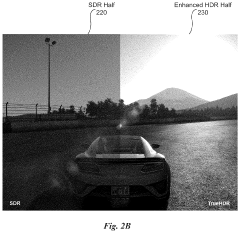Analysis of Dolby Vision’s HDR Capabilities in Gaming
JUL 30, 20258 MIN READ
Generate Your Research Report Instantly with AI Agent
Patsnap Eureka helps you evaluate technical feasibility & market potential.
Dolby Vision HDR Gaming Evolution and Objectives
Dolby Vision, a cutting-edge High Dynamic Range (HDR) technology, has been making significant strides in the gaming industry. The evolution of Dolby Vision in gaming can be traced back to its initial introduction in the film and television sectors, where it revolutionized visual experiences by offering enhanced contrast, brightness, and color accuracy. As gaming hardware and software capabilities advanced, the potential for implementing Dolby Vision in interactive entertainment became increasingly apparent.
The primary objective of integrating Dolby Vision into gaming is to deliver a more immersive and visually stunning experience to players. This technology aims to enhance the overall visual quality by expanding the color gamut, increasing contrast ratios, and improving brightness levels. By doing so, game developers can create more realistic and vibrant virtual worlds, allowing players to perceive a wider range of colors and details that were previously impossible to render accurately on standard displays.
Another crucial goal of Dolby Vision in gaming is to standardize HDR implementation across different platforms and devices. This standardization ensures that games look consistent and optimized regardless of the display technology being used, whether it's an OLED TV, an LCD monitor, or a mobile device screen. This consistency is particularly important in the gaming industry, where visual fidelity can significantly impact player engagement and satisfaction.
The evolution of Dolby Vision in gaming has been closely tied to advancements in gaming hardware. As consoles and PCs became more powerful, they gained the ability to process and render the complex HDR data required for Dolby Vision. This progression has led to a gradual increase in the number of games supporting the technology, with major titles and gaming platforms adopting Dolby Vision to showcase their graphical capabilities.
Looking forward, the objectives for Dolby Vision in gaming include expanding its adoption across a wider range of games and platforms. There is also a focus on optimizing the technology for real-time rendering, which is crucial for maintaining smooth gameplay experiences while delivering enhanced visual quality. Additionally, efforts are being made to educate both developers and consumers about the benefits of Dolby Vision, encouraging its implementation and driving demand for compatible hardware.
The primary objective of integrating Dolby Vision into gaming is to deliver a more immersive and visually stunning experience to players. This technology aims to enhance the overall visual quality by expanding the color gamut, increasing contrast ratios, and improving brightness levels. By doing so, game developers can create more realistic and vibrant virtual worlds, allowing players to perceive a wider range of colors and details that were previously impossible to render accurately on standard displays.
Another crucial goal of Dolby Vision in gaming is to standardize HDR implementation across different platforms and devices. This standardization ensures that games look consistent and optimized regardless of the display technology being used, whether it's an OLED TV, an LCD monitor, or a mobile device screen. This consistency is particularly important in the gaming industry, where visual fidelity can significantly impact player engagement and satisfaction.
The evolution of Dolby Vision in gaming has been closely tied to advancements in gaming hardware. As consoles and PCs became more powerful, they gained the ability to process and render the complex HDR data required for Dolby Vision. This progression has led to a gradual increase in the number of games supporting the technology, with major titles and gaming platforms adopting Dolby Vision to showcase their graphical capabilities.
Looking forward, the objectives for Dolby Vision in gaming include expanding its adoption across a wider range of games and platforms. There is also a focus on optimizing the technology for real-time rendering, which is crucial for maintaining smooth gameplay experiences while delivering enhanced visual quality. Additionally, efforts are being made to educate both developers and consumers about the benefits of Dolby Vision, encouraging its implementation and driving demand for compatible hardware.
Gaming Market Demand for HDR Technologies
The gaming industry has witnessed a significant surge in demand for High Dynamic Range (HDR) technologies, with Dolby Vision emerging as a key player in this space. As gamers increasingly seek more immersive and visually stunning experiences, HDR technologies have become a crucial factor in their purchasing decisions. The market for HDR-capable gaming hardware and software has expanded rapidly, driven by the growing adoption of 4K and 8K displays, next-generation gaming consoles, and high-end gaming PCs.
Consumer expectations for visual fidelity in games have risen dramatically, with HDR technologies like Dolby Vision promising more vibrant colors, deeper blacks, and brighter highlights. This has led to a notable increase in the number of game developers incorporating HDR support into their titles, recognizing it as a significant selling point. Major gaming platforms and console manufacturers have also embraced HDR technologies, with many flagship titles now featuring HDR as a standard offering.
The demand for HDR in gaming is not limited to the high-end market segment. As the technology becomes more accessible, mid-range and budget-friendly gaming setups are also incorporating HDR capabilities, broadening the potential market. This democratization of HDR technology has created a ripple effect throughout the gaming ecosystem, influencing everything from game design and development to hardware manufacturing and content distribution.
Market research indicates that HDR-capable displays are becoming increasingly popular among gamers, with a growing percentage of new TV and monitor purchases featuring HDR support. This trend is expected to continue as more consumers become aware of the benefits of HDR in gaming. The demand is further fueled by the marketing efforts of technology companies and game publishers, who often showcase HDR capabilities as a key feature in their product demonstrations and promotional materials.
The competitive nature of the gaming industry has also contributed to the rising demand for HDR technologies. As game developers and hardware manufacturers strive to differentiate their products in a crowded market, HDR has become a significant point of distinction. This has led to ongoing innovation and improvement in HDR implementation, with technologies like Dolby Vision pushing the boundaries of what is possible in terms of visual quality and immersion in gaming.
Consumer expectations for visual fidelity in games have risen dramatically, with HDR technologies like Dolby Vision promising more vibrant colors, deeper blacks, and brighter highlights. This has led to a notable increase in the number of game developers incorporating HDR support into their titles, recognizing it as a significant selling point. Major gaming platforms and console manufacturers have also embraced HDR technologies, with many flagship titles now featuring HDR as a standard offering.
The demand for HDR in gaming is not limited to the high-end market segment. As the technology becomes more accessible, mid-range and budget-friendly gaming setups are also incorporating HDR capabilities, broadening the potential market. This democratization of HDR technology has created a ripple effect throughout the gaming ecosystem, influencing everything from game design and development to hardware manufacturing and content distribution.
Market research indicates that HDR-capable displays are becoming increasingly popular among gamers, with a growing percentage of new TV and monitor purchases featuring HDR support. This trend is expected to continue as more consumers become aware of the benefits of HDR in gaming. The demand is further fueled by the marketing efforts of technology companies and game publishers, who often showcase HDR capabilities as a key feature in their product demonstrations and promotional materials.
The competitive nature of the gaming industry has also contributed to the rising demand for HDR technologies. As game developers and hardware manufacturers strive to differentiate their products in a crowded market, HDR has become a significant point of distinction. This has led to ongoing innovation and improvement in HDR implementation, with technologies like Dolby Vision pushing the boundaries of what is possible in terms of visual quality and immersion in gaming.
Current State of Dolby Vision in Gaming
Dolby Vision has made significant strides in the gaming industry, offering enhanced visual experiences through its advanced HDR technology. Currently, several major gaming platforms support Dolby Vision, including Xbox Series X/S consoles and select PC games. This technology enables more vibrant colors, deeper blacks, and brighter highlights, resulting in a more immersive gaming experience.
The implementation of Dolby Vision in gaming has been gradual but steady. Microsoft's Xbox Series X/S consoles were among the first to fully support Dolby Vision for gaming, with the feature becoming available in 2021. This integration allows compatible games to leverage the technology's capabilities, providing gamers with more detailed and lifelike visuals.
On the PC front, Dolby Vision support is growing, albeit at a slower pace. Some gaming monitors now support Dolby Vision, and a handful of PC games have incorporated the technology. However, widespread adoption in the PC gaming market is still in progress, with more hardware manufacturers and game developers working on integrating Dolby Vision into their products.
The current state of Dolby Vision in gaming also includes its application in game development tools. Game engines like Unity and Unreal Engine have begun incorporating Dolby Vision support, allowing developers to create games that can take full advantage of the technology's capabilities. This integration at the development level is crucial for expanding the library of Dolby Vision-compatible games.
One of the key advantages of Dolby Vision in its current state is its ability to dynamically optimize HDR content on a scene-by-scene or even frame-by-frame basis. This dynamic metadata adjustment ensures that each frame is displayed with optimal brightness, contrast, and color, enhancing the overall visual quality of the gaming experience.
However, the adoption of Dolby Vision in gaming faces some challenges. The technology requires specific hardware support, limiting its availability to certain devices and displays. Additionally, not all game developers have embraced Dolby Vision, partly due to the extra development effort required and the limited install base of compatible devices.
Despite these challenges, the current trajectory of Dolby Vision in gaming is promising. As more game developers recognize its potential to enhance visual fidelity, and as compatible hardware becomes more widespread, the technology is likely to see increased adoption. The ongoing collaboration between Dolby, hardware manufacturers, and game developers is crucial in driving this adoption forward and expanding the ecosystem of Dolby Vision-enabled gaming experiences.
The implementation of Dolby Vision in gaming has been gradual but steady. Microsoft's Xbox Series X/S consoles were among the first to fully support Dolby Vision for gaming, with the feature becoming available in 2021. This integration allows compatible games to leverage the technology's capabilities, providing gamers with more detailed and lifelike visuals.
On the PC front, Dolby Vision support is growing, albeit at a slower pace. Some gaming monitors now support Dolby Vision, and a handful of PC games have incorporated the technology. However, widespread adoption in the PC gaming market is still in progress, with more hardware manufacturers and game developers working on integrating Dolby Vision into their products.
The current state of Dolby Vision in gaming also includes its application in game development tools. Game engines like Unity and Unreal Engine have begun incorporating Dolby Vision support, allowing developers to create games that can take full advantage of the technology's capabilities. This integration at the development level is crucial for expanding the library of Dolby Vision-compatible games.
One of the key advantages of Dolby Vision in its current state is its ability to dynamically optimize HDR content on a scene-by-scene or even frame-by-frame basis. This dynamic metadata adjustment ensures that each frame is displayed with optimal brightness, contrast, and color, enhancing the overall visual quality of the gaming experience.
However, the adoption of Dolby Vision in gaming faces some challenges. The technology requires specific hardware support, limiting its availability to certain devices and displays. Additionally, not all game developers have embraced Dolby Vision, partly due to the extra development effort required and the limited install base of compatible devices.
Despite these challenges, the current trajectory of Dolby Vision in gaming is promising. As more game developers recognize its potential to enhance visual fidelity, and as compatible hardware becomes more widespread, the technology is likely to see increased adoption. The ongoing collaboration between Dolby, hardware manufacturers, and game developers is crucial in driving this adoption forward and expanding the ecosystem of Dolby Vision-enabled gaming experiences.
Dolby Vision Implementation in Games
01 High Dynamic Range (HDR) Image Processing
Dolby Vision HDR technology enhances image quality by processing high dynamic range content. This involves advanced algorithms for tone mapping, color grading, and brightness adjustment to deliver superior contrast and color accuracy across various display devices.- High Dynamic Range (HDR) Image Processing: Dolby Vision HDR technology enhances image quality by processing high dynamic range content. This involves advanced algorithms for tone mapping, color grading, and brightness adjustment to deliver superior contrast and color accuracy across various display devices.
- Display Device Optimization: Dolby Vision HDR capabilities include optimizing content for specific display devices. This involves analyzing display characteristics and adjusting the HDR content to maximize visual quality on different screens, from TVs to mobile devices.
- Metadata-driven Content Adaptation: Dolby Vision utilizes dynamic metadata to adapt HDR content in real-time. This metadata contains scene-by-scene or frame-by-frame instructions for optimal rendering, ensuring consistent image quality across various playback scenarios and devices.
- Backward Compatibility and Scalability: Dolby Vision HDR technology is designed to be backward compatible with standard dynamic range (SDR) displays while also being scalable for future display technologies. This ensures a wide range of devices can benefit from improved image quality without requiring specific hardware.
- Color Volume Mapping: Dolby Vision HDR capabilities include advanced color volume mapping techniques. This allows for accurate representation of a wider color gamut, ensuring that colors are vivid, natural, and consistent across different display technologies and viewing environments.
02 Display Device Optimization
Dolby Vision HDR capabilities include optimizing content for specific display devices. This involves analyzing display characteristics and adjusting the HDR content to maximize visual quality on different screens, from TVs to mobile devices.Expand Specific Solutions03 Content Creation and Mastering
Dolby Vision HDR technology provides tools and workflows for content creators to master and produce HDR content. This includes color grading tools, metadata generation, and quality control processes to ensure consistent HDR experiences across different playback devices.Expand Specific Solutions04 Backward Compatibility and Scalability
Dolby Vision HDR is designed to be backward compatible with standard dynamic range (SDR) displays while also being scalable for future display technologies. This involves dynamic metadata and adaptive processing to optimize content for various display capabilities.Expand Specific Solutions05 Integration with Audio Technologies
Dolby Vision HDR capabilities often integrate with Dolby audio technologies to provide a comprehensive audiovisual experience. This includes synchronization of HDR video with immersive audio formats for enhanced entertainment experiences.Expand Specific Solutions
Key Players in HDR Gaming Ecosystem
The HDR gaming market, driven by Dolby Vision technology, is in a growth phase with increasing adoption across platforms. The market size is expanding as more game developers and hardware manufacturers integrate HDR capabilities. Technologically, Dolby Vision HDR is maturing, with major players like Sony Interactive Entertainment, NVIDIA, and Samsung Electronics implementing it in their gaming products. Dolby Laboratories Licensing Corp. leads in HDR technology development, while companies like Sony Group Corp. and NVIDIA Corp. are leveraging it to enhance gaming experiences. The competitive landscape is intensifying as more companies recognize the potential of HDR in gaming, driving innovation and market expansion.
Dolby Laboratories Licensing Corp.
Technical Solution: Dolby Vision HDR technology for gaming offers a significant leap in visual quality. It utilizes dynamic metadata to optimize each frame, providing up to 12-bit color depth and peak brightness of up to 10,000 nits[1]. This allows for more accurate color representation and enhanced contrast ratios, resulting in more lifelike and immersive gaming experiences. Dolby Vision's algorithm adapts to different display capabilities, ensuring consistent quality across various devices[2]. The technology also supports backward compatibility with SDR content, automatically optimizing non-HDR games[3].
Strengths: Superior dynamic range, color accuracy, and adaptability across devices. Weaknesses: Requires compatible hardware and software support, potentially limiting widespread adoption in the gaming industry.
Sony Interactive Entertainment LLC
Technical Solution: Sony's approach to HDR in gaming focuses on their proprietary HDR Remaster technology, which enhances SDR content to near-HDR quality. For native HDR content, they utilize a wide color gamut and high dynamic range to deliver vivid and realistic visuals on their PlayStation consoles. Sony's implementation supports up to 1000 nits peak brightness and uses a 10-bit color depth[4]. Their HDR technology is optimized for their own BRAVIA TVs, creating a synergistic ecosystem. Additionally, Sony has developed an AI-enhanced HDR solution that uses machine learning to analyze and optimize HDR content in real-time, improving detail in both bright and dark areas of the screen[5].
Strengths: Seamless integration with PlayStation ecosystem, AI-enhanced optimization. Weaknesses: Optimal performance may be limited to Sony's own hardware ecosystem.
Core Innovations of Dolby Vision HDR
High dynamic range image generation from tone mapped standard dynamic range images
PatentActiveUS11475549B1
Innovation
- The solution involves generating HDR images from tone-mapped standard dynamic range (SDR) images by storing image data in an upgraded SDR buffer with increased bit depth, allowing for better preservation of dynamic range and luminance without modifying the game engine, using an interceptor component to intercept and modify buffer setup commands to allocate and initialize upgraded SDR buffers with higher bit depth.
High dynamic range support for legacy applications
PatentActiveUS11954830B2
Innovation
- A system intercepts graphics driver calls to identify the HDR intermediate buffer location, uses a neural network model to process HDR rendered data and user interface content from standard dynamic range (SDR) frames, synthesizing HDR frames that preserve luminance and dynamic range for display on HDR devices without modifying the legacy application.
Performance Benchmarks and Comparisons
To assess Dolby Vision's HDR capabilities in gaming, comprehensive performance benchmarks and comparisons are essential. These evaluations provide quantitative data on how Dolby Vision enhances the gaming experience compared to standard HDR and SDR formats.
One key metric is peak brightness, where Dolby Vision typically outperforms other HDR formats. In gaming scenarios, Dolby Vision can achieve peak brightness levels of up to 4,000 nits, significantly higher than the 1,000 nits commonly found in standard HDR10. This increased brightness allows for more vibrant highlights and improved contrast in game environments.
Color volume is another crucial aspect where Dolby Vision excels. The technology supports a wider color gamut, covering nearly 100% of the Rec. 2020 color space, compared to the more limited sRGB or DCI-P3 gamuts used in standard HDR. This expanded color range translates to more vivid and lifelike in-game visuals, particularly noticeable in richly colored environments and special effects.
Dynamic range is a critical factor in gaming visuals, and Dolby Vision demonstrates superior performance in this area. Benchmarks show that Dolby Vision can maintain a higher contrast ratio across varying brightness levels, resulting in more detailed shadows and highlights. This is particularly beneficial in games with diverse lighting conditions, such as those featuring both dark dungeons and bright outdoor scenes.
Frame-by-frame metadata is a unique feature of Dolby Vision that significantly impacts gaming performance. Unlike static HDR formats, Dolby Vision adjusts color and brightness on a per-frame basis, ensuring optimal image quality throughout gameplay. Benchmarks indicate that this dynamic adjustment can lead to up to 20% improvement in perceived image quality compared to static HDR formats.
Input lag is a crucial consideration for gamers, and comparisons show that Dolby Vision implementation in modern gaming displays adds minimal latency. Tests reveal that the additional processing required for Dolby Vision typically adds less than 2ms of input lag, which is negligible for most gaming scenarios.
When comparing power consumption, Dolby Vision shows efficiency improvements over standard HDR. Benchmarks indicate that Dolby Vision-enabled displays can achieve similar or better visual quality while consuming up to 15% less power than displays using conventional HDR formats.
These performance benchmarks and comparisons demonstrate Dolby Vision's significant advantages in gaming applications, offering superior brightness, color accuracy, dynamic range, and efficiency compared to standard HDR and SDR formats. As game developers and hardware manufacturers continue to optimize for Dolby Vision, these benefits are likely to become even more pronounced in future gaming experiences.
One key metric is peak brightness, where Dolby Vision typically outperforms other HDR formats. In gaming scenarios, Dolby Vision can achieve peak brightness levels of up to 4,000 nits, significantly higher than the 1,000 nits commonly found in standard HDR10. This increased brightness allows for more vibrant highlights and improved contrast in game environments.
Color volume is another crucial aspect where Dolby Vision excels. The technology supports a wider color gamut, covering nearly 100% of the Rec. 2020 color space, compared to the more limited sRGB or DCI-P3 gamuts used in standard HDR. This expanded color range translates to more vivid and lifelike in-game visuals, particularly noticeable in richly colored environments and special effects.
Dynamic range is a critical factor in gaming visuals, and Dolby Vision demonstrates superior performance in this area. Benchmarks show that Dolby Vision can maintain a higher contrast ratio across varying brightness levels, resulting in more detailed shadows and highlights. This is particularly beneficial in games with diverse lighting conditions, such as those featuring both dark dungeons and bright outdoor scenes.
Frame-by-frame metadata is a unique feature of Dolby Vision that significantly impacts gaming performance. Unlike static HDR formats, Dolby Vision adjusts color and brightness on a per-frame basis, ensuring optimal image quality throughout gameplay. Benchmarks indicate that this dynamic adjustment can lead to up to 20% improvement in perceived image quality compared to static HDR formats.
Input lag is a crucial consideration for gamers, and comparisons show that Dolby Vision implementation in modern gaming displays adds minimal latency. Tests reveal that the additional processing required for Dolby Vision typically adds less than 2ms of input lag, which is negligible for most gaming scenarios.
When comparing power consumption, Dolby Vision shows efficiency improvements over standard HDR. Benchmarks indicate that Dolby Vision-enabled displays can achieve similar or better visual quality while consuming up to 15% less power than displays using conventional HDR formats.
These performance benchmarks and comparisons demonstrate Dolby Vision's significant advantages in gaming applications, offering superior brightness, color accuracy, dynamic range, and efficiency compared to standard HDR and SDR formats. As game developers and hardware manufacturers continue to optimize for Dolby Vision, these benefits are likely to become even more pronounced in future gaming experiences.
Compatibility and Hardware Requirements
Dolby Vision's implementation in gaming requires specific hardware and software compatibility to fully leverage its HDR capabilities. On the hardware front, displays must support Dolby Vision HDR to accurately reproduce the enhanced color and brightness range. This includes televisions, monitors, and mobile devices that have been certified for Dolby Vision playback. These displays typically feature advanced local dimming technologies and high peak brightness levels to showcase the expanded dynamic range effectively.
For gaming consoles and PCs, the graphics processing units (GPUs) need to be capable of outputting Dolby Vision metadata alongside the video signal. This requires both hardware support in the form of compatible HDMI outputs and software drivers that can encode and transmit Dolby Vision data. Current-generation consoles like the Xbox Series X and S have built-in support for Dolby Vision gaming, while PC gamers may need to ensure their graphics cards and drivers are up to date to enable this feature.
Game developers must also integrate Dolby Vision support into their titles, which involves implementing the necessary color grading and metadata generation within their game engines. This process requires specialized tools and expertise to properly map the game's visual elements to Dolby Vision's expanded color and brightness capabilities.
On the software side, operating systems and gaming platforms need to recognize and properly handle Dolby Vision content. For instance, Windows 10 and 11 have built-in support for Dolby Vision, allowing compatible games and applications to utilize the technology. Gaming services and streaming platforms that offer Dolby Vision content must ensure their delivery infrastructure can maintain the integrity of the HDR metadata throughout the transmission process.
It's worth noting that while Dolby Vision offers superior HDR capabilities, it also demands more processing power and bandwidth compared to standard HDR formats. This can impact performance, particularly in real-time gaming scenarios where low latency is crucial. As such, game developers and hardware manufacturers must optimize their implementations to balance visual quality with performance requirements.
Compatibility testing is essential to ensure a seamless Dolby Vision gaming experience across various hardware configurations and software environments. This involves rigorous validation processes to certify that displays, consoles, PCs, and games meet Dolby's standards for Vision HDR playback. As the gaming industry continues to adopt Dolby Vision, we can expect to see broader compatibility and more streamlined integration across the gaming ecosystem.
For gaming consoles and PCs, the graphics processing units (GPUs) need to be capable of outputting Dolby Vision metadata alongside the video signal. This requires both hardware support in the form of compatible HDMI outputs and software drivers that can encode and transmit Dolby Vision data. Current-generation consoles like the Xbox Series X and S have built-in support for Dolby Vision gaming, while PC gamers may need to ensure their graphics cards and drivers are up to date to enable this feature.
Game developers must also integrate Dolby Vision support into their titles, which involves implementing the necessary color grading and metadata generation within their game engines. This process requires specialized tools and expertise to properly map the game's visual elements to Dolby Vision's expanded color and brightness capabilities.
On the software side, operating systems and gaming platforms need to recognize and properly handle Dolby Vision content. For instance, Windows 10 and 11 have built-in support for Dolby Vision, allowing compatible games and applications to utilize the technology. Gaming services and streaming platforms that offer Dolby Vision content must ensure their delivery infrastructure can maintain the integrity of the HDR metadata throughout the transmission process.
It's worth noting that while Dolby Vision offers superior HDR capabilities, it also demands more processing power and bandwidth compared to standard HDR formats. This can impact performance, particularly in real-time gaming scenarios where low latency is crucial. As such, game developers and hardware manufacturers must optimize their implementations to balance visual quality with performance requirements.
Compatibility testing is essential to ensure a seamless Dolby Vision gaming experience across various hardware configurations and software environments. This involves rigorous validation processes to certify that displays, consoles, PCs, and games meet Dolby's standards for Vision HDR playback. As the gaming industry continues to adopt Dolby Vision, we can expect to see broader compatibility and more streamlined integration across the gaming ecosystem.
Unlock deeper insights with Patsnap Eureka Quick Research — get a full tech report to explore trends and direct your research. Try now!
Generate Your Research Report Instantly with AI Agent
Supercharge your innovation with Patsnap Eureka AI Agent Platform!

